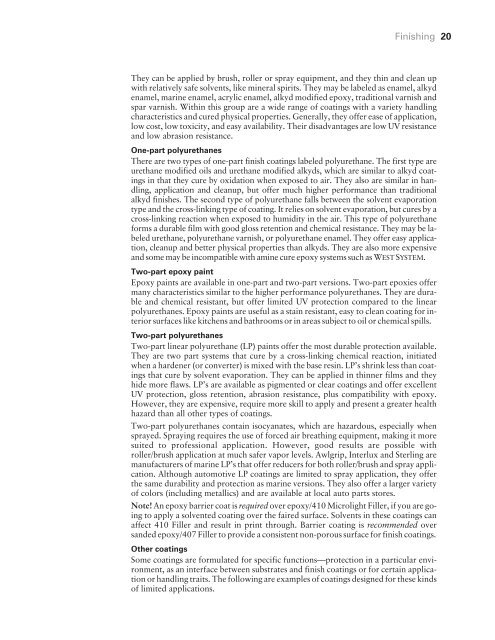Final Fairing & Finishing - WEST SYSTEM Epoxy
Final Fairing & Finishing - WEST SYSTEM Epoxy
Final Fairing & Finishing - WEST SYSTEM Epoxy
You also want an ePaper? Increase the reach of your titles
YUMPU automatically turns print PDFs into web optimized ePapers that Google loves.
<strong>Finishing</strong> 20<br />
They can be applied by brush, roller or spray equipment, and they thin and clean up<br />
with relatively safe solvents, like mineral spirits. They may be labeled as enamel, alkyd<br />
enamel, marine enamel, acrylic enamel, alkyd modified epoxy, traditional varnish and<br />
spar varnish. Within this group are a wide range of coatings with a variety handling<br />
characteristics and cured physical properties. Generally, they offer ease of application,<br />
low cost, low toxicity, and easy availability. Their disadvantages are low UV resistance<br />
and low abrasion resistance.<br />
One-part polyurethanes<br />
There are two types of one-part finish coatings labeled polyurethane. The first type are<br />
urethane modified oils and urethane modified alkyds, which are similar to alkyd coatings<br />
in that they cure by oxidation when exposed to air. They also are similar in handling,<br />
application and cleanup, but offer much higher performance than traditional<br />
alkyd finishes. The second type of polyurethane falls between the solvent evaporation<br />
type and the cross-linking type of coating. It relies on solvent evaporation, but cures by a<br />
cross-linking reaction when exposed to humidity in the air. This type of polyurethane<br />
forms a durable film with good gloss retention and chemical resistance. They may be labeled<br />
urethane, polyurethane varnish, or polyurethane enamel. They offer easy application,<br />
cleanup and better physical properties than alkyds. They are also more expensive<br />
and some may be incompatible with amine cure epoxy systems such as <strong>WEST</strong> <strong>SYSTEM</strong>.<br />
Two-part epoxy paint<br />
<strong>Epoxy</strong> paints are available in one-part and two-part versions. Two-part epoxies offer<br />
many characteristics similar to the higher performance polyurethanes. They are durable<br />
and chemical resistant, but offer limited UV protection compared to the linear<br />
polyurethanes. <strong>Epoxy</strong> paints are useful as a stain resistant, easy to clean coating for interior<br />
surfaces like kitchens and bathrooms or in areas subject to oil or chemical spills.<br />
Two-part polyurethanes<br />
Two-part linear polyurethane (LP) paints offer the most durable protection available.<br />
They are two part systems that cure by a cross-linking chemical reaction, initiated<br />
when a hardener (or converter) is mixed with the base resin. LP’s shrink less than coatings<br />
that cure by solvent evaporation. They can be applied in thinner films and they<br />
hide more flaws. LP’s are available as pigmented or clear coatings and offer excellent<br />
UV protection, gloss retention, abrasion resistance, plus compatibility with epoxy.<br />
However, they are expensive, require more skill to apply and present a greater health<br />
hazard than all other types of coatings.<br />
Two-part polyurethanes contain isocyanates, which are hazardous, especially when<br />
sprayed. Spraying requires the use of forced air breathing equipment, making it more<br />
suited to professional application. However, good results are possible with<br />
roller/brush application at much safer vapor levels. Awlgrip, Interlux and Sterling are<br />
manufacturers of marine LP’s that offer reducers for both roller/brush and spray application.<br />
Although automotive LP coatings are limited to spray application, they offer<br />
the same durability and protection as marine versions. They also offer a larger variety<br />
of colors (including metallics) and are available at local auto parts stores.<br />
Note! An epoxy barrier coat is required over epoxy/410 Microlight Filler, if you are going<br />
to apply a solvented coating over the faired surface. Solvents in these coatings can<br />
affect 410 Filler and result in print through. Barrier coating is recommended over<br />
sanded epoxy/407 Filler to provide a consistent non-porous surface for finish coatings.<br />
Other coatings<br />
Some coatings are formulated for specific functions—protection in a particular environment,<br />
as an interface between substrates and finish coatings or for certain application<br />
or handling traits. The following are examples of coatings designed for these kinds<br />
of limited applications.
















